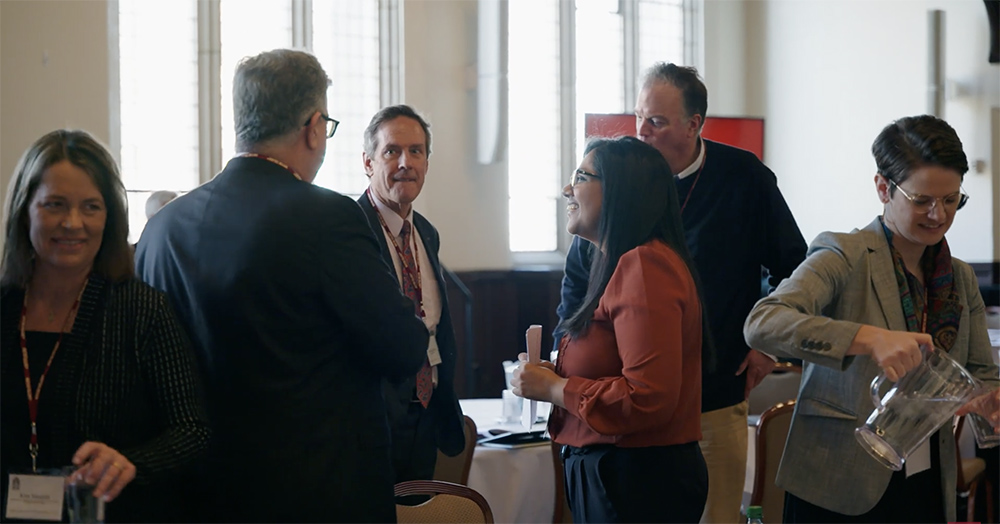
Participants are seen conversing in the video on the conference "The Way Forward: Pope Francis, Vatican II, and Synodality," held at Boston College March 3-4. (NCR screenshot/YouTube/Center on Religion and Culture)
I am a text person. I do not listen to podcasts. I cannot really explain why da Vinci's "Mona Lisa" leaves me cold but Titian's nearby "L'Homme au Gant" strikes me as beautiful. I turn on the TV to relax, and prefer "Law & Order" reruns, "Masterpiece Theater" and TCM to any news channel. My home is filled with books, not DVDs.
And so, when it was suggested to the organizers of our ecclesial gathering on synodality in March at Boston College that we contract with a videographer, I was skeptical. This gathering was sponsored by Boston College's Boisi Center, Fordham University's Center on Religion and Culture, and Loyola University Chicago's Hank Center, and it was heavy on academic keynotes and panels. I wrote about it at the time.
After the first meeting with America Media's Sebastian Gomes, however, I was a convert. He asked different questions from those I or the other organizers had asked. He approached the two-day event not from the standpoint of content, but as a storyteller. I began to see the value of engaging him and his talented team.
The result exceeded my expectations. It was finished last week, a short 10-minute video.
There are a couple things the video captures that my poor prose only hinted at. One was the significance of the liturgical celebrations.
After the Boston College event, I wrote: "The combination of time spent socializing with time for prayer together, and serious intellectual and pastoral discussions, is what has transformed these two events into an ecclesial gathering rather than the typical academic conference." That is true, but so inadequate.
Gomes' video highlights the importance of shared prayer: the beauty of the chapel in St. Mary's Hall, the stained glass and stone arches reminding us of our Catholic faith's longevity and commitment to beauty.
The acoustics of the room need to be heard to be appreciated, and in the video, they are. Barbara Hill, a very talented soprano, sings the Bach-Gounod "Ave Maria," accompanied by Ryan Lynch playing the exquisite one-manual Flentrop organ. The recording was made after the conference participants had headed back to Gasson Hall for lunch, but Hill sang the piece at Communion time on the second day of the conference. It was beautiful and transported listeners as only music can.
Advertisement
Music and the liturgy. The Mass itself, the familiarity of the prayers and the celebrant's gestures, the word of God broken open by a homilist, the centurion's words that we make our own — "Lord, I am not worthy that you should enter under my roof, but only say the word ..." — all these both unite and anchor these conferences. Everyone knows when to stand and when to kneel. No one needs to look at the program to sing the "Agnus dei."
The sense of ownership implicit in the words "the people of God" seems less like a metaphor and more like an eyewitness report. This sharing in the Eucharist is the ground from which fruitful conversations spring.
Another thing that came through clearly in the video is the importance of including Catholic leaders who are neither bishops nor theologians: CEOs of major Catholic ministries — like Mercy Sr. Mary Haddad of the Catholic Health Association and Sean Callahan of Catholic Relief Services — philanthropists, journalists and Catholic labor leaders.
When you see people taking off their jackets or talking to each other during coffee breaks, it is usually these people who moved most easily between the two primary groups of bishops and theologians. At the dinners, too, they were social glue.
When you are one of the organizers of these events, you necessarily focus on the problems. A few days before the event, one of our speakers announced he was unable to procure his visa in time to join us. We had to scramble to set up Zoom capability in Gasson Hall, the 110-year-old building where we held the sessions. You need to make sure the coffee is being set up, and that the late-arriving bishop knows where to have the taxi drop him off.
It is easy to forget how beautiful the venue is and, Lord, Gasson Hall and St. Mary's chapel are gorgeous venues.
Finally, the video captures the conviviality of these gatherings. Conviviality is not the same thing as affability. Its Latin root — "convivium" or banquet — is in turn rooted in the Latin words for "with" and "living." They point to something deeper than affability or charm.
It is rewarding to be in a roomful of people who care about the church as much as you do and who have given their lives to it as you have. It is with such people that greetings are easy and quickly give way to discussion and collaboration.
This video demonstrates what we are trying to accomplish in these gatherings far better than my columns have done. Kudos to Gomes and his team.








